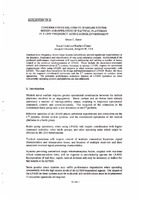| dc.contributor.author | Spear, Bruce C. | |
| dc.date.accessioned | 2018-10-11T14:05:47Z | |
| dc.date.available | 2018-10-11T14:05:47Z | |
| dc.date.issued | 1993/08 | |
| dc.identifier | 813 | |
| dc.identifier.govdoc | CP-42/2 | |
| dc.identifier.uri | http://hdl.handle.net/20.500.12489/146 | |
| dc.description.abstract | Low-Frequency Active Sonar System (LFASS) can provide significant improvements in the detection, localization and classification of very quiet submarine contacts. Achievement of the predicted performance improvements will require addressing and solving a number of issues related to the technical implementation of LFASS. These include the associated command, control, and communication (C3) systems necessary to operate LFASS, impacts on operational requirements while using LFASS, and impacts to other systems operated concurrently with LFASS. This paper does not address the design and implementation ofLFASS. Rather, the focus is on the required coordinated operations and the C3 systems necessary to conduct those operations. The potential performance reduction impacts of LFASS operation on other concurrently operating systems and platforms are also addressed. | |
| dc.format | 11 p. : ill., 15 fig. ; digital, PDF file | |
| dc.language | English | |
| dc.publisher | NATO. SACLANTCEN | |
| dc.source | In: Low frequency active sonar (SACLANTCEN Conference Proceedings CP-42), vol. 2, 1993, pp. K/30-1 - K/30-11. | |
| dc.subject | Low Frequency Active Sonar (LFAS) | |
| dc.subject | Command and control systems | |
| dc.subject | Naval warfare and operations | |
| dc.subject | Anti-Submarine Warfare (ASW) | |
| dc.subject | Military communications | |
| dc.title | Considerations related to warfare system design and operation of tactical platforms in a low- frequency active sonar environment | |
| dc.type | Papers and Articles | |
| dc.type | Conference Proceedings (CP) | |
